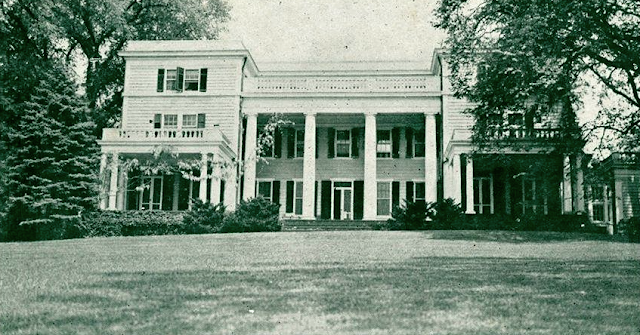 |
The Rose-Dor Farms mansion, originally the Nearwood and later Care’s End (or Caresend) mansion is shown in a 1947 postcard image after its reconstruction in the early 1920s. The original mansion was destroyed by fire in 1921. (Screen capture of 1947 vintage postcard)
|
Nearwood, an estate of some 15 acres at the southeast intersection of Hamilton Road and South Broadway in Irvington, was home to financial and political movers and shakers of the 19th and 20th centuries.
Dibble was a successful Manhattan merchant, and one of four members of the first Irvington Board of Trustees in April 1872.
Nearwood’s original 27-room mansion sat on 15 landscaped acres at what became 141 South Broadway. The estate was bordered to the north by Hamilton Road and later to the south by Cyrus West Field’s massive “Ardsley” estate. Nevis lay to the west between Broadway and the Hudson River.
Nearwood included stables, a coach house (later a 15-car garage) and greenhouse according to a real estate ad in the June 1911 edition of House & Garden magazine. It would eventually house a solarium annex with game rooms downstairs, indoor and outdoor swimming pools, tennis courts, a horse riding ring and other outdoor ballfields and play areas.
Another building on the estate would house three apartments, likely for estate employees.
The estate was held sometime before 1905 by James Cunningham Bishop, village-born scion of Irvington royalty -- grandson of James Cunningham and son of Heber and Mary Cunningham Bishop who themselves owned Gilded Age estates off North Broadway near Sunnyside Lane.
Bishop had a large staff living with him and in buildings on the estate, including 10 household servants, a governess, coachman, groomsman, stable hand, two laborers and a father-son head gardener/assistant gardener tandem.
Divorce prompted Bishop to leave town and sell the estate to one of America’s richest men, Irving Ter Bush.
 |
Irving Ter Bush’s Scottish-built steam yacht Christabel is shown in a photo prior to World War I. The yacht, which was regarded as one of the largest and finest berthed on the Hudson River, was sold by Bush to the U.S. Navy and it served during World War I as the USS Christabel (SP-162) from 1917-19. It sailed off the western coast of Europe protecting allied convoys and damaged the German submarine UC-56 off Spain’s Atlantic coast on May 21, 1918. Christabel was originally credited with sinking UC-56, but the heavily damaged sub limped into the neutral port of Santander, Spain three days later. The sub and its crew were interned. (Wikimedia Commons)
|
Bush headed the Bush Terminal Company. He built Brooklyn’s Bush Terminal/Industry City at the turn of the 20th century, Bush Tower in 1918 on on West 42nd Street between Broadway and Sixth Avenue in Manhattan and Bush House -- the most expensive building in the world at the time -- in London after 1925.
Bush owned one of the Hudson River’s most famous yachts, the Christabel, and hosted a party on it in 1915, sailing from the Philipsburg Manor dock in nearby Sleepy Hollow.
The Christabel went on to military fame as a convoy patrol escort after being sold by Bush to the U.S. government on April 30, 1917 and being converted for military use.
USS Christabel steamed out of Brest, France and on May 21, 1918, attacked and damaged the German submarine UC-56 off Spain’s Atlantic coast. Christabel was originally credited with sinking UC-56, but the heavily damaged sub limped into the neutral port of Santander, Spain three days later. The sub and its crew were interned and lost to the Germans for the duration of the war.
Bush sold the estate in February 1921 to DuPont and General Motors financial and corporate executive F. Donaldson Brown. Brown renamed the estate “Care’s End,” commonly referred to thereafter as Caresend.
 |
| Care's End (or Caresend) is shown in an aerial photo of the estate ca. 1932-34 by Robert Yarnall Richie during the ownership of General Motors and DuPont executive F. Donaldson Brown. (Robert Yarnall Richie Photograph Collection, DeGolyer Library, Southern Methodist University Libraries) |
The mansion was destroyed in an April 1921 fire but was rebuilt, and expanded to 43 rooms. Brown sold the estate in 1937 to former CBS public relations executive-turned women’s health resort operator Robert S. Taplinger.
Taplinger renamed the estate Rose-Dor Farms and ran a women’s health and fitness facility at the estate until 1952 when it was sold and became Wood-Lane Country Day School and Wood-Lane Country Day Camp (during summers).
Wood-Lane was alternately spelled Woodlane.
In 1965 it was sold again and remained a school, this time the Montessori School of Irvington. Later the property was sold, the mansion and outbuildings razed and redeveloped as a site of single-family homes.
 |
Jacob D. Dibble’s Nearwood estate is shown south of today's Hamilton Road (“Private Way” on the map) and east of South Broadway next to Henry H. Cannon’s estate to the north and Cyrus West Field’s massive “Ardsley” estate to the south in this 1881 hand drawn map. Remaining parcels of Colonel James A. Hamilton's Nevis estate are shown to Cannon's north and east and Dibble's south and west. Nevis (not labeled) lies directly across Broadway from Nearwood, immediately south of the Fletcher Harper estate known as Beechlawn. Harper was the founder of the famed Harper's Weekly magazine. (George Washington Bromley and Walter Scott Bromley, 1881, David Rumsey Map Collection)
|














Comments
Post a Comment
If you would like to weigh-in, feel free ...